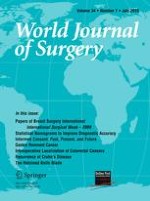Published in:

01-07-2010
Deep Venous Thrombosis After Surgery for Inflammatory Bowel Disease: Is Standard Dose Low Molecular Weight Heparin Prophylaxis Enough?
Authors:
Marco Scarpa, Fabio Pilon, Vittorio Pengo, Giovanna Romanato, Cesare Ruffolo, Francesca Erroi, Bison Elisa, Mauro Frego, Elena Ossi, Enzo Manzato, Imerio Angriman
Published in:
World Journal of Surgery
|
Issue 7/2010
Login to get access
Abstract
Background
Inflammatory bowel disease (IBD) and colorectal surgery are risk factors for deep venous thrombosis (DVT). The aim of this prospective study was to evaluate the effectiveness of standardized prophylactic low molecular weight heparin (LMWH) therapy in patients who underwent surgery for ulcerative colitis (UC) and Crohn’s disease (CD).
Patients and methods
Since 1999 all patients operated on for colorectal diseases in our institute have received 4,000 IU/day LMWH from the day of operation to discharge. The complete series of patients who had major colorectal surgery from 1999 until 2006 were reviewed for overt DVT episodes. Furthermore, 60 consecutive patients who were admitted for surgery for IBD were prospectively enrolled in the 2004–2006 period. Each patient underwent venous color Doppler ultrasound scan at admission and at discharge. Demographic data, disease activity, and clotting parameters were collected. Data were analyzed with Spearman’s correlation test, multiple regression, and receiver operating characteristics (ROC) curves analysis.
Results
The rate of DVT in UC patients was significantly higher than in colorectal cancer patients (p = 0.009), and the odds ratio (OR) for postoperative DVT in UC patients was 7.4 (95% CI 1.4–44.4; p = 0.017). Female gender, UC diagnosis, active rectal bleeding, aPTT value, aCL IgM, aβ2 IgM, and pANCA levels significantly correlated with postoperative DVT. At multivariate analysis only aCL IgM levels were found to be independently associated with postoperative DVT (p = 0.05).
Conclusions
In conclusion, our study showed that prophylactic therapy with 4,000 IU/day LMWH was not completely effective for the prevention of postoperative DVT in patients with CD, and even less so in those with UC. In these patients, a more tailored prophylactic therapy should be considered, and further randomized controlled trials testing the effectiveness of different prophylactic protocols would be advisable. Furthermore, aCL IgM serum levels might be helpful in identifying IBD patients who are at higher risk of postoperative DVT.